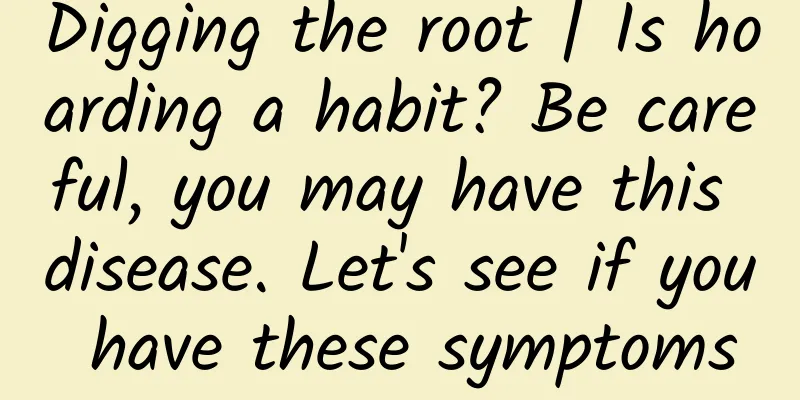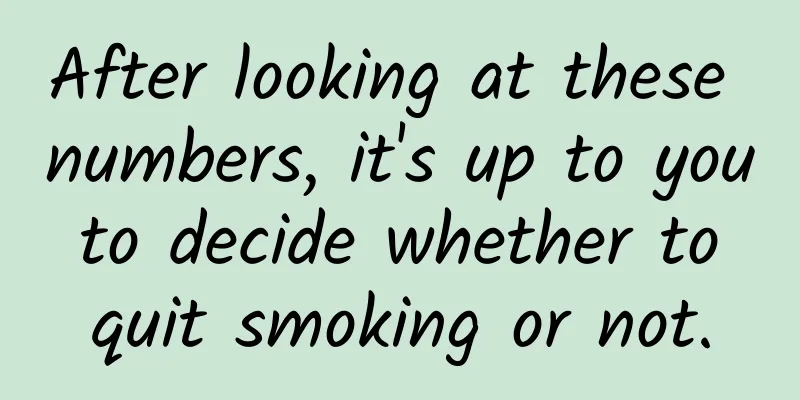Digging the root | Is hoarding a habit? Be careful, you may have this disease. Let's see if you have these symptoms

|
gossip Many people are reluctant to throw away the items they have hoarded. Although it is common to store daily necessities and food, if a large number of items are piled up in the living space, it will affect the normal daily life. In particular, if the objects hoarded have little value and function, or even have a negative impact on environmental hygiene and health, it should be considered as a pathological condition. Many people believe that hoarding is a matter of personal habit, and it is a habit exclusive to the elderly. But is this really the case? analyze Like most human behaviors, collecting or storing items can range from normal adaptive behavior to pathological behavioral disorders. Excessive hoarding behavior is called hoarding disorder . The scientific community currently believes that hoarding disorder is a mental illness that can occur at any age, which appears at an early age, usually in childhood or adolescence, and its severity increases with age. With the change in the definition and diagnostic criteria of hoarding disorder, the research group was expanded to the general population, and the incidence rate was between 2% and 5%. Copyrighted stock images, no reproduction is authorized Young people's "excessive hoarding" is attracting more attention Because of the need to move, 29-year-old Xiao K (the author's friend) had to face up to his accumulated wealth: there was basically no extra space from the ground to the roof in the two-bedroom, one-living room house, and everything was piled up in disorder and chaos. Needless to say, the clothing and daily necessities, the shoe storage box alone blocked an entire wall. There was no place to step in the kitchen and bathroom, and every cabinet, shelf, behind the door, and under the sink was in a state of "overflowing to the point of exploding." Little K doesn’t throw things away. He washes the used fast food boxes from takeout and piles them up in the kitchen. He also “picks up” things at home: such as old newspapers, plastic bags, and unopened medical cotton swabs for throat swabs. He doesn’t pick up things for any purpose, he just feels satisfied when he takes them home. Many things have gone bad and expired, and many are so old that they have completely lost their function (such as the draft books with scribblings in elementary school). But if he tries to clean them up, Little K feels that he “can’t do it”: “I can’t help but collect them, but I can’t make up my mind to throw them away.” Excessive hoarding has affected Xiao K's life. He never invites friends to his home, and in fact there is no space to entertain anyone. He once had a girlfriend who was shocked by his living environment and tried to help him clean up some of his belongings. Xiao K refused, so they had a fierce argument and eventually broke up. After that, Xiao K felt it was difficult for others to understand his living habits, and he didn't want to try to have close interpersonal relationships anymore. "I know that my accumulation of things to this extent may be a bit pathological." Xiao K said that when he first saw the word "hoarding disorder", he automatically identified himself with it and knew that he might need to see a doctor. But so far, he is not willing to take the initiative to change, because densely packed and full spaces bring a sense of security, and he "likes the feeling of being surrounded by things." Hoarding disorder is a cognitive behavioral developmental disorder. It is characterized by compulsive purchase or excessive acquisition of free and unnecessary items. In 2013, the fifth edition of the Diagnostic and Statistical Manual of Mental Disorders (DSM-5) of the United States separated hoarding disorder from obsessive-compulsive disorder and established it as a new type of mental illness. Hoarding disorder is defined as a mental illness that is not caused by other known diseases, which is caused by a series of psychological and behavioral disorders caused by the perceived need to store items and difficulty in discarding or separating from items. The diagnostic criteria for hoarding disorder in the fifth edition of the Diagnostic and Statistical Manual of Mental Disorders are: A. Persistent difficulty discarding or giving away items, regardless of their actual value. B. This difficulty is due to the felt need to accumulate items and the pain associated with discarding them. C. Difficulty in discarding items leads to an accumulation of items that crowds and clutters the living area in use and significantly impairs its usefulness. If the living area is not cluttered, it is only because of the intervention of a third party (e.g., family member, cleaner, authority figure). D. The hoarding causes clinically significant distress or impairment in social, occupational, or other important areas of functioning (including maintaining a safe environment for self and others). E. The hoarding is not attributable to another medical disorder (eg, brain injury, cerebrovascular disease, Prader-Willi syndrome). F. The hoarding symptoms are not better explained by another psychiatric disorder (obsessions, such as in obsessive-compulsive disorder; decreased energy, such as in major depressive disorder; delusions, such as in schizophrenia or other psychotic disorders; cognitive deficits, such as in major neurocognitive disorder; or restricted interests, such as in autism spectrum disorder). In fact, young people's hoarding behavior is also gradually attracting attention. The developed cyberspace has allowed many new concepts to surface, such as the once popular "forced decluttering" lifestyle concept, the emergence of home organizers, and the birth of a new profession of "paying someone to throw things away." In many online groups, young people who call themselves "hoarders" show off their hoarding results, often accompanied by the painful struggle of "wanting to throw away but not being able to, and having to buy but not being able to." Copyrighted stock images, no reproduction is authorized The results of a survey on hoarding among Chinese college students conducted from May to June 2018 showed that among the 2,204 respondents, 93 (4.22%) met the diagnostic criteria for hoarding disorder, 628 (28.49%) met the tendency for hoarding disorder, a total of 721 (32.71%) met the criteria for hoarding phenomenon, and another 438 (19.07%) had hoarding behavior but did not meet the criteria for hoarding phenomenon. The phenomenon of hoarding among male students is higher than that among female students, and the difference is statistically significant. The survey also shows that the phenomenon of hoarding among Chinese college students is influenced by eight factors: gender, high monthly living expenses, low subjective well-being, love of comparison, thrift, nostalgia, lack of social support, and spiritual emptiness. There is an essential difference between "hoarding" and "collecting": Characteristics of Hoarding Disorder Research shows that people with hoarding disorder lack insight into their own behavior, which may be partly related to certain cognitive biases. Although many people call themselves "hoarders," true hoarders often believe that their acquisition and preservation of items are justified, deny that their behavior is bad, and refuse treatment. People with more severe hoarding disorder may seek treatment for depression and anxiety, which often result from frustration with their hoarding behavior : having no place to store their possessions, having their possessions moved or discarded without permission, or having to give up some of their possessions. "Hoarding" is not the same as collecting. Although both collectors and people with hoarding disorder like to store things and spend a lot of time, energy and space on it, collectors are proud of their collections, while people with hoarding disorder are often embarrassed by their hoards and don't want others to see them. In addition, collectors have a budget and plan to purchase and place a certain type or several types of collections, while people with hoarding disorder often pile up their collections in a disorderly manner and are not fixed. The items may be worthless or even harmful (garbage). Another key point is that people with hoarding disorder often develop a pathological attachment to objects. When they discard some non-functional and meaningless objects, they will feel intense pain and feel as if they have lost a part of themselves. We do need to recognize the possibility that pathological "collecting" may develop into hoarding disorder, but appropriate collecting hobbies are normal and fundamentally different from hoarding disorder; there is no need to label normal collecting hobbies as "hoarding disorder." Pathogenesis and treatment What kind of people are more likely to develop hoarding disorder? Foreign studies have shown that the elderly, people who have experienced traumatic events, and people with personality traits such as dependence and social avoidance are more likely to develop hoarding disorder. However, in traditional Chinese culture, the influence of the concept of making the best use of things and being thrifty also needs to be taken into consideration. There is still controversy about how suitable the diagnostic criteria for hoarding disorder and the corresponding influencing factors are for the Chinese cultural background. Copyrighted stock images, no reproduction is authorized At present, the clinical explanation of the pathogenesis of hoarding disorder can be summarized into three aspects: First, childhood experience. Hoarding disorder may be related to childhood experiences, such as early childhood trauma, insecure attachment, and stressful life events. Second, neurobiological mechanisms. Research on neural mechanisms has found that hoarding disorder symptoms may be related to abnormal activation of certain brain regions. Third, genetic factors. Hoarding disorder may be hereditary, and about 50% of relatives of people with hoarding disorder also have hoarding behavior. Treatments for hoarding disorder are also being developed and studied. Initially, they were based on the treatment of obsessive-compulsive disorder, but now they have evolved into different treatment approaches based on the focus of treatment, including cognitive behavioral therapy, drug therapy, and comprehensive treatment. The prominent cognitive features of hoarding disorder are irrational beliefs about items, inability to control hoarding behavior, and difficulty perceiving the serious consequences of hoarding behavior. Therefore, some researchers believe that these are the core causes of hoarding disorder, and the key to treatment is to change the patient's erroneous cognition and control hoarding behavior. Taking antidepressant and anxiety drugs can effectively relieve the anxiety and depression associated with hoarding disorder patients and alleviate hoarding behavior to a certain extent. However, there is currently relatively little research on drug treatments for the disease itself, and drug therapy may have some side effects and needs to be used with caution. Comprehensive treatment is a combination of psychological intervention and drug therapy. It emphasizes cognitive behavioral therapy as the basis, supplemented by necessary drug therapy, and can achieve certain therapeutic effects. in conclusion Hoarding is not necessarily a habit problem. Excessive hoarding, collecting or storing items may be a hoarding disorder. Hoarding disorder is not unique to the elderly. The severity of symptoms varies in different age groups, and some people may have hoarding disorder from youth to middle-aged and elderly. In the context of China's "thrifty" culture, many people do not easily realize that hoarding behavior may also be a symptom. They often wait until their homes are filled with garbage and they have serious conflicts with their families before they realize that they have a problem. Regardless of age, if a family member shows abnormal hoarding tendencies, the first priority is to pay attention to it as soon as possible and seek medical treatment in a timely manner. For family members who have already shown hoarding behavior, more understanding and communication are needed. Simply and crudely forcing "letting go" is not advisable. Author: Dou Yuanyuan, psychological counselor, medical/psychology popular science author Reviewer: Ren Feng, MD, PhD Director of the Department of Psychiatry, Shougang Hospital, Peking University, Standing Committee Member of the Psychiatry Branch of the Beijing Medical Association References: 1.Liu Yong, Ma Donghua, Du Yulai, et al. The impact of hoarding behavior on college students' depression: the multiple sequential mediating effects of social exclusion, belonging frustration, and perceived burden[J]. Chinese Journal of Clinical Psychology, 2021, 29(05): 1050-1054+1059. DOI: 10.16128/j.cnki.1005-3611.2021.05.032. 2. Du Jianzheng, Jing Weili. Behavioral and psychological characteristics of hoarding disorder and related factors[J]. Psychological Science, 2014, 37(04): 993-997. DOI: 10.16719/j.cnki.1671-6981.2014.04.004. 3. Xu Xiaoyu. Conceptual definition, diagnostic measurement and mechanism intervention of hoarding disorder[J]. Psychological Technology and Application, 2020, 8(07): 440-448. DOI: 10.16842/j.cnki.issn2095-5588.2020.07.007. 4. Zheng Yanan, Liu Dixiu. Investigation on hoarding phenomenon and influencing factors among Chinese college students[J]. Chinese Journal of Public Health, 2020, 36(10): 1474-1477. 5. Liu Yong, Chen Jianzhi, Song Linting, et al. Symptoms, diagnosis and treatment of hoarding disorder[J]. Advances in Psychological Science, 2013, 21(12): 2184-2195. The article is produced by "Science Refutes Facts" (ID: Science_Facts). Please indicate the source when reprinting. The cover image and images within this article are from the copyright gallery. Reprinting and quoting them may lead to copyright disputes. |
>>: Why do you feel déjà vu? It may be your brain correcting its own mistakes!
Recommend
"WeChat finally supports multiple devices online at the same time" is on the hot search, but netizens are still dissatisfied: they want more
As a social APP under Tencent with more than 1 bi...
The complete guide to RxSwift that all the masters are reading
RxSwift is a project I have been following on Git...
Would you buy a phone that costs $6,800?
On October 4, luxury phone maker Vertu launched a...
How does a facial recognition access control corporate website intercept long-tail keywords?
A few days ago, a friend asked in the group, why ...
Why You Should Try Full Stack
When programmers see the concept of full stack, t...
5 major elements and 2 types of landing page design!
Normally, in the marketing process, many companie...
Remdesivir clinical trial! What is remdesivir? What is the price?
As of February 7, a total of 31,214 cases of nove...
Promotion strategy of Sina Weibo Fanstong
Someone told me that Sina Weibo’s scale is not up...
Guilin Moving Mini Program Franchise Price Query, How much is the franchise price for Guilin Moving Mini Program?
How much does it cost to join a moving app in Gui...
The new mobile app rankings for 2020 are released
The number of mobile Internet users this month re...
Does removing the "asterisk" mean relaxing prevention and control? Wu Zunyou's answer
On June 30, Wu Zunyou posted a message on his per...
Livestreaming sales training camp: community + short video + livestreaming sales: earning 100,000 yuan from one livestreaming
Course Catalog of Live Streaming Thinking Six tho...
3 million transactions in 14 days, practical tutorial for community course selling project!
The topic I want to share with you today is: Detai...
A Guide to the Evolution of Cognitive Event Operations
Today I will mainly talk about the topic of event...









